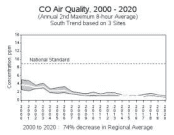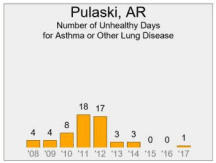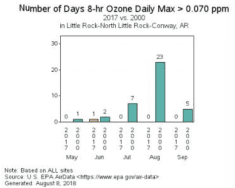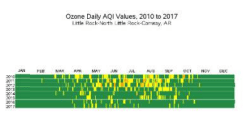Poor Air Quality (Dust, Pollutants, Smoke)
Data Limitations
Geographical and spatial gaps exist, especially in rural areas. However, areas distant from monitoring stations typically experience consistently good air quality. Also, there is no single air pollutant relevant to every discussion, so there is no single way to express air quality (Tracking California 2021). Monitoring frequency varies by pollutant (e.g., carbon monoxide, nitrogen dioxide, sulfur dioxide, and lead). Tools often display data for the five air pollutants that make up the Air Quality Index (AQI): carbon monoxide, nitrogen dioxide, ozone, particulate matter (PM10 and PM2.5) and sulfur dioxide.
Definition and Description
A measure of the monitored natural and man-made pollutants in an area.
Air quality problems result from the accumulation of aerosols, such as dust, pollen, smoke, salt, or human-produced chemically-active compounds that build up in an area over time. Under normal conditions, winds disperse these aerosols and compounds, but sustained periods of light winds can allow buildup to unhealthy levels. Many aerosols are produced naturally but may have artificially elevated concentrations through burning (concentration of smoke and carbon monoxide) or agriculture. Industrial activities and urban environments add other sources of pollution, including photochemical smog, which is produced from the interaction of sunlight with nitrous oxides (primarily from automobile engines) and volatile organic compounds. Ozone is a component of this smog.
Air quality problems occur when dispersion – the ability of the atmosphere to spread pollutants over a large area – is inhibited. Temperature inversions, where a warm layer of air aloft prevents upward motion, and light winds, such as a large high-pressure system, provide favorable conditions for air quality events. Some pollutants, such as ozone, occur in higher concentrations during higher temperatures and more intense sunlight while others, such as smoke or dust, can accumulate in high concentrations any time of the year. Local and regional landscapes, such as mountain valleys, can also “trap” pollutants. Warmer summertime temperatures are likely to increase the concentration of pollutants such as ozone.
Concentrations of pollutants are measured and averaged over time. A time-averaged concentration is used because exposure to a high concentration of pollutants during a short time might have an impact equivalent to an exposure to a lower concentration over a longer time (American Meteorological Society). When the average exceeds public health regulations over a defined period, such as several hours or a day or a number of days per year, the area is noted as being noncompliant. One way to assess air quality for your location is to look at the daily Air Quality Index (AQI) issued by the U.S Environmental Protection Agency. AQI is calculated for five major pollutants including ground-level ozone, particle pollution (particulate matter), carbon monoxide, sulfur dioxide, and nitrogen dioxide.
Historical Data
Air Trends
(Period varies by pollutant; up to 1990-2022) U.S. Environmental Protection AgencyThis static image displays the annual national and regional trends for the 5 AQI pollutants as well as for lead.
1. To obtain graphs, scroll down page slightly and click on pollutant link of interest in the Air Quality Trends section on the left side of the page. 2. Scroll to the bottom of the page to the Regional Trends Section. 3. Select South from the list. 4. Graph will display on the bottom of the page.
Air Compare
(2012-2021) U.S. Environmental Protection AgencyThis interactive map displays county-based trends for the five AQI air pollutants that may affect human health. For data limitations specific to this tool, including the pollutants that are accounted for in the analyses, click on the Basic Info tab at the top of the page, then Data Limitations on the right side of the page. Note: For information on the predominant directions in which air pollutants flow, refer to the Wind Rose Plots tool in the Wildfire section.
1. Scroll down until you see the U.S map. 2. In the upper left-hand corner of the map, click on Trends, then select group of interest. 3. Click county of interest to obtain graph of annual statistics. 4. For data broken down into months, click on Seasons in upper left-hand corner, then select group of interest.
Ozone Exceedances
(1980-present)U.S. Environmental Protection AgencyThis interactive graphing tool compares 8-hour ozone exceedances between two years or multi-year periods for a city or county. Comparisons are shown by day, month and year. The ozone exceedance level for this tool is 0.070ppm.
1. Under Geographic Area, select a City or County (Arkansas cities listed: Arkadelphia, Fayetteville-SpringdaleRogers, Fort Smith, Harrison, and Little Rock-North Little Rock-Conway) 2. Under Baseline Period, select either a single year or a multi-year period and the year(s) in which you are interested. 3. Under Comparison Period, select either a single year or a multi-year period and the year(s) in which you are interested in. 4. You may need to uncheck Use ALL Monitors when comparing time periods if data aren’t available for both periods. 5. Click Plot Data.
Outdoor Air Quality Data
(Period varies by pollutant; up to 1980-present) U.S. Environmental Protection AgencyThis multiyear tile plotting tool shows the daily AQI pollutant values for a specific location or time period. Each tile represents one day of the year and is color-coded based on the AQI level for that day.
1. Under Pollutant, select pollutant of choice. (ex: Ozone, All AQI Pollutants) 2. Under Period, select a beginning and ending year 3. Under Geographical Area, select a city or county (Note: cities available are listed in the Ozone Exceedances tool above; will depend on each pollutant) 4. Click Plot Data.
Climate Change Trends
Arkansas generally meets all federal air quality standards for criteria pollutants (UA 2023). However, the EPA’s Cross-State Air Pollution Rule Update from 2022 requires Arkansas’s power plants to reduce nitrous oxide emissions that can cross state lines and contribute to ground-level ozone (EPA 2022). Hotter temperatures can increase the formation of ground-level ozone, which has a variety of health effects including asthma and respiratory problems (EPA 2016). Ground-level ozone pollution is projected to increase across Arkansas due to warming summer temperatures (Carter et al. 2014). Air quality may also worsen during wildfire periods (EPA 2016). Continued technological innovation and enforcement of federal regulations should result in additional air quality improvement (ODEQ 2018). Learn more about future air quality in Climate Change Science and Projection Resources.




